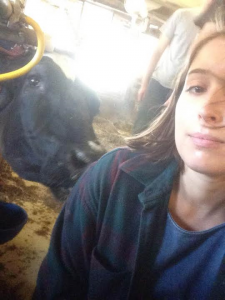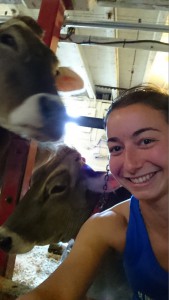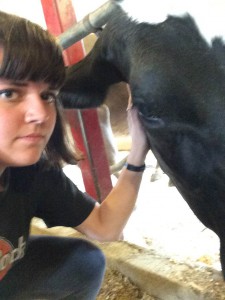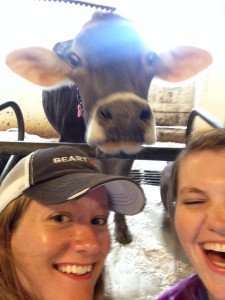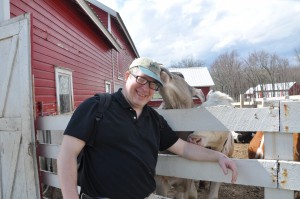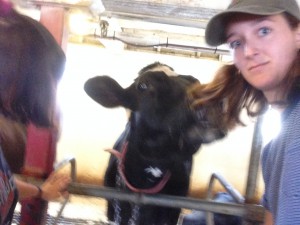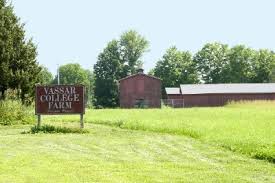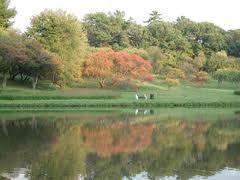Hey, my name is Juliette and I’m from Los Angeles. I’ve spent very little time on farms and am excited to explore more places like Stormfield Swiss! Here’s a picture of me getting eaten by a cow.
New Friends
Making New Friends
Hi, I’m Lily! I’m a senior American Studies major from New York City. I first became interested in sustainable agriculture during my time at a VT dairy farm in high school, and am excited to learn more about its role in the Hudson Valley! Here is a picture of me and my new best friend at Stormfield Swiss in Wappinger’s Falls.
Happy April!
Stormfield Swiss Cows!!!
Baynard and a Cow
Cow Love
Union Square Greenmarket
Last week, I boarded the green line of the Metro North Railroad and embarked on a scenic train ride down the Hudson River to 14th street and 5th avenue. After emerging from the subway stop in the middle of Union Square park, I was greeted by many rows of colorful tents and farm stands occupied by equally colorful proprietors.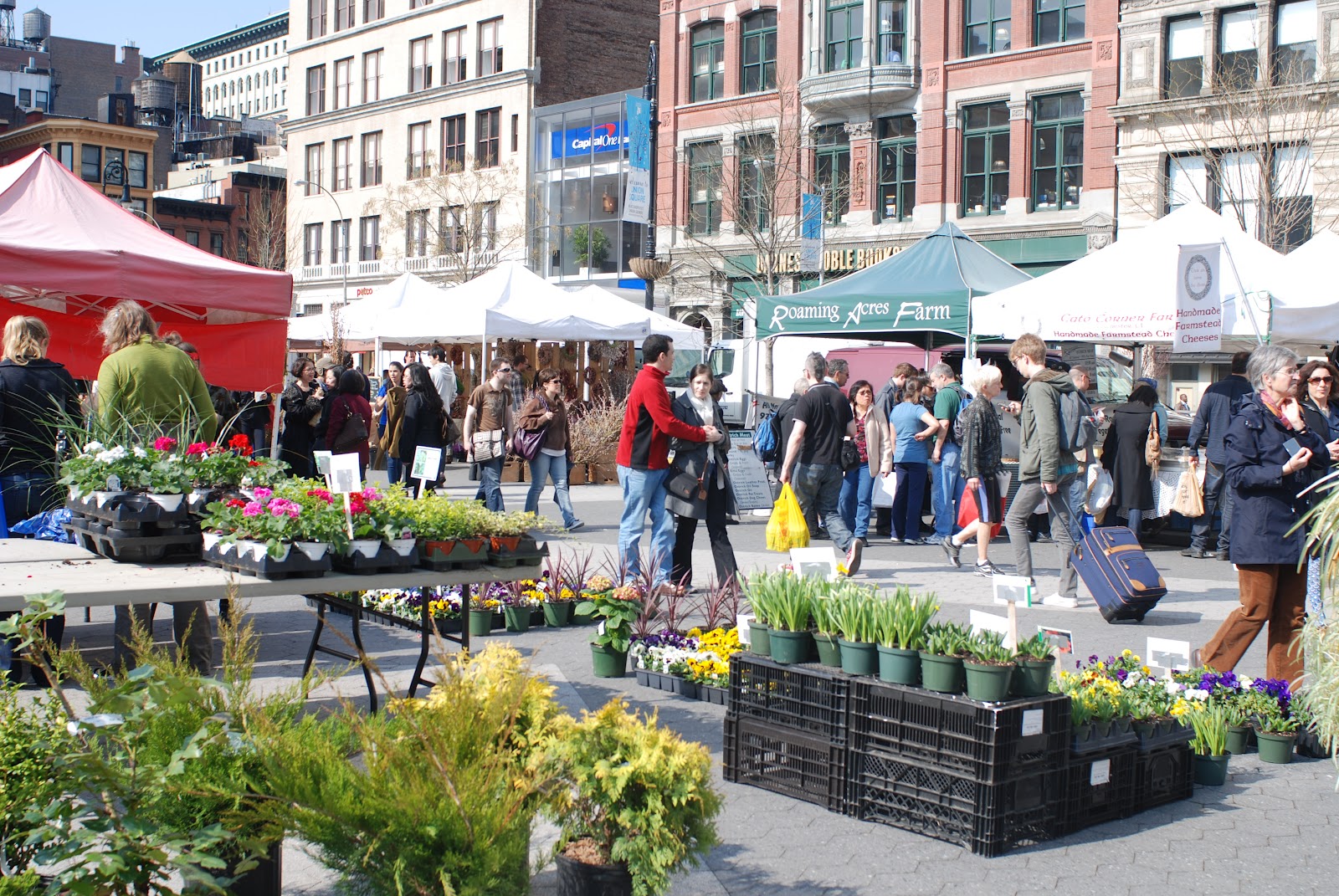
I initially took one cursory stroll down the main thoroughfare in order to waft the sweet smells of crisp produce and observe the diversity of local merchandise. The products varied from morning-baked muffins, specially-cured meats, home-made iced teas, and even freshly-potted plants! However, the main focus is obviously locally-grown fruits and vegetables. I conducted some secondary research on the Grown NYC website and learned that after its founding in 1976, the Greenmarket now boasts 140 regional farmers, fisherman and bakers and approximately 60,000 regular attendees. While the patrons are mostly local Manhattan and Brooklyn residents, some vendors travel from as far as Burlington, Vermont in order to participate in the exchange.
One such vendor was Chris Wheat from the Hudson Valley Duck Farm, whose agrarian surname pre-destined his tenure at the Greenmarket. Mr. Wheat told me that the 200-acre, cage-free operation, originally a chicken farm based out of Allenville, Pennsylvania, is now located in Ferndale, New York, and they’ve been doing business for close to 20 years. They specialize in Moulard ducks, but they also raise a special heritage breed called Lola. Not surprisingly, their main commodities are various duck meats (breasts, legs, sausage, bacon, salami, prosciutto), but they also export value-added products like rendered duck fat and foie gras.
I also spoke with Lou from Roaming Acres Farm in Montclair, New Jersey, whose idiosyncratic focus is ostrich meat. Although this exact business was founded in 2005, its primary owner Todd, has been in the meat industry for 15 years. Like Mr. Wheat’s duck farm, their feed is notably 100% vegetarian, and their output varies from standard cuts of ostrich meat to eggs, leather, oil and even soap! Lou particularly sold me on his ostrich jerky, asserting that it was both higher in iron than beef and lower in fat than chicken without its skin. I tried a little of this red meat poultry for myself, and it was indeed very delicious.
These two merchants numbered among dozens of different farmers and artisans that constitute Wednesday’s market. However, on other days of operation, there is an entirely different cast of characters offering their unique, local merchandise, so I would encourage all enthusiasts of local agriculture to hop on a train to the city and check it out!
The Fiber of Backyard Life
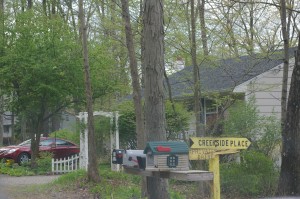
Few would know it, but just 15 minutes outside of Poughkeepsie, in a little suburban neighborhood in Pleasant Valley, NY there’s something quite interesting, something that all started when two parents decided to educate themselves and their children on raising and working with livestock. The Millers started with just two alpacas, but by 2006, their venture had spread over a variety of farm animals (the original alpacas, then goats, chickens, and even a llama). Before they knew it, they had a full-fledged operation on their hands, and they named it Creekside Acres Fiber Farm. Sitting on just an acre and a half of grazing land behind the Miller’s house, this full-fledged agricultural business hardly looks much bigger than a backyard.
Creekside Acres is a CSA fiber farm, which means at the start of every season, they have a group of friends, colleagues, and avid fiber workers invest in their herd. They take care of their animals with this investment over the winter, and come Spring-time, when the goats and alpacas are clipped, these investors get back a share of the season’s clippings, either in raw form, or as yarn. To get an understanding of scale, Creekside Acres sells the smallest share for $150, which amounts to 4% of their yearly harvest. They offer approximately 19 of these shares to the public.

If you’ve done the math for that, you can see it doesn’t amount to much, especially thinking of the labor costs in taking care of the animals and spinning the raw wool into yarn. However, the CSA element is only one of many business opportunities Candice Miller saw in their home farm. Not only do they sell wool and yarn, both in the CSA, wholesale, and at county fairs (look for their stand at this year’s Sheep and Wool Festival in Rheinbeck), but in the off season, the Millers use their animals both for profit and for the good of the community.
The growing diversity of the farm means that they are always learning about new animals, and in turn, teaching about them. They open their farm up to the local 4H club for kids of all ages to learn about where and how cloth comes into existence. They frequently have 4H volunteers on their farm, working alongside them to take care of the animals. This diversity also opened them up to the opportunity to run what they call a travelling petting farm. Farm to You Revue might at first look like your average petting zoo, but the Millers have gone to great efforts to make it more approachable and educational. They do the traditional birthday parties and events, but they are also present in schools and summer camps. They travel with a group of animals that can range from ponies and llamas to baby ducks and reptiles. The goal of this venture is to create additional revenue to sustain the farm, while bringing a farm-like experience to children who would not normally have the opportunity. In their presentations, they teach their students about how the animals live, and why they are kept, with an interactive element – a lot of petting, some bottle-feeding of baby goats, leading of smaller animals, and gentle handling of fowl and reptiles.
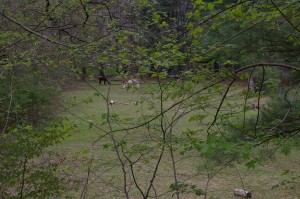
Enjoy Spring in the Vassar Farm
On May 8, I have gone to Vassar farm which is located near the Vassar college.
Vassar Farm has a long history. The 200 acres vassar farm land was purchased by Vassar Brother hospital to create a settling field and filter beds to approach the waste in 1895. In 1911, the land was incorporate with another southern 300 acres of the current preserve to become single tract. According to the 1918-19 Vassar College Catalogue, the farm included “a model dairy and poultry farm, greenhouses, stables, storage barns and farm houses….[It] produces vegetables for the college table, and grain and fodder for the cattle and poultry. The dairy supplies milk and cream for the college from a tested herd of Holstein cattle.” The Vassar girls worked firstly in World War I and II when the extra help during the summer months was in short supply, which build a spacial relationship between the land and College.After a short term closed off, the farm has been utilized again as an ecological preserve for conservation and research in 1976.
There is a multiple use area in the northeastern portion of vassar farm. A small piece was used as a part of Poughkeepsie Farm project. Vassar Rugby and Cross Country team can also play games here. Vassar members conduct research on the ecological preserve. And the Field Station also contribute to the teaching and research of natural history, ecology, botany, environmental education, and earth science. There are many modern facilities in the field station. You can imagine how cool when you study in the field station where outside there is a vast farm land!
The Vassar farm is so beautiful. There is a diversity of habitats such as streams, wetlands, forest in the surrounding area. you can do so many things in your vacation day. Walking, hiking and biking in the land you can discover a world different from the New York City.
The food production is still a part of Vassar farm. There are many gardeners in the farm who are industrious and interesting. I can learn much about the life and agriculture when I talked with them. I believe the most part of the food in deece are from Vassar Farm. That is why the food in Vassar college is so delicious!
There are many kinds of animals in the Vassar farm. You can observe field sparrows, bluebirds, red-tailed hawks, rabbits, and even migrating bobolinks amongst the grasses and goldenrod. Because the fields and forests combined with the surrounding urban yard provide food supplies, there are many deer here. The deer management plan has been adopted to protect and preserve the ecological diversity of the land.
The field trip to the Vassar farm was amazing. Walk outside to enjoy spring in the Vassar Farm and Ecological Preserve!
